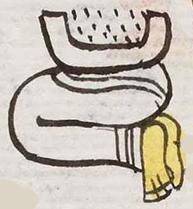Chinantla (Mdz13v)
This compound glyph for the place name Chinantla (glossed as though it is Nantzintlan, which is probably unlikely, according to Gordon Whittaker's dissertation of 1980) has two principal elements with a third mixed in. The upper element is the seed, chiyan, which provides the phonetic start to chinamitl, the agricultural strip. The lower half of a woman is apparently meant to elicit mother (nantli), which is an element in Chinantla. Her posture could put an emphasis on her bottom (tzintli), but it also is semantic for "woman." The woman is wearing a white skirt. Her bare feet are yellow. Above her body is a white bowl of a liquid with dots (effervescence?), which may suggest pulque (octli), although this has no phonetic role in the place name only a semantic one. The -tlan locative suffix is not shown visually in this glyph.
Stephanie Wood
To further emphasize a reading of mother, there is a bowl above the lower half of a woman. The bowl contains a number of black dots resembling a bowl of pulque (a mildly alcoholic beverage that women made), although the classic symbol for pulque (like a ram's horns) does not appear here. (Compare, below, right.) Furthermore, the beverage represented is open to interpretation. Two scholars have suggested that the bowl contains a medicinal remedy made from nantzin xocotl, a native plum, which was known to help women in labor. So pregnancy, delivery, and maternity are thereby stretching the meaning of woman (cihuatl) to mother (nantli). See Berdan and Anawalt, Codex Mendoza (1992), vol. 1, 194. As Frances Karttunen points out, the nantzin xocotl fruit came into Mexican Spanish as nance (also seen as nanche), leading to her reading of this place as "Nance Place."
Stephanie Wood
nantzintlan. puo
Nantzintlan, pueblo
Stephanie Wood
c. 1541, or by 1553 at the latest
Stephanie Wood
rear ends, bottoms, buttocks, mothers, woman, women, herbal remedies, nalgas, trasero, mujeres, madres, medicinas herbales

nantzin xocotl, a medicinal fruit, https://nahuatl.wired-humanities.org/content/nantzin-xocotl
nan(tli), https://nahuatl.wired-humanities.org/content/nantli
tzin(tli), rear end, rump, bottom, https://nahuatl.wired-humanities.org/content/tzintli
-tzin (reverential suffix), https://nahuatl.wired-humanities.org/content/tzin
xoco(tl), a native plum, https://nahuatl.wired-humanities.org/content/xocotl
-tlan (locative suffix), place of, https://nahuatl.wired-humanities.org/content/tlan
"Nance [or Nanche] Place" [Frances Karttunen, unpublished manuscript, used here with her permission.]
"Where There Are Many Revered Mothers" or "Where There is Much Nantzinxocotl" (Berdan and Anawalt, 1992, vol. 1, p. 194)
Stephanie Wood
Codex Mendoza, folio 13 verso, https://digital.bodleian.ox.ac.uk/objects/2fea788e-2aa2-4f08-b6d9-648c00..., image 37 of 188.
The Bodleian Libraries, University of Oxford, hold the original manuscript, the MS. Arch. Selden. A. 1. This image is published here under the UK Creative Commons, “Attribution-NonCommercial-ShareAlike 3.0 License” (CC-BY-NC-SA 3.0).




